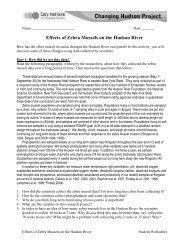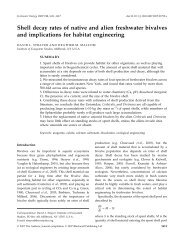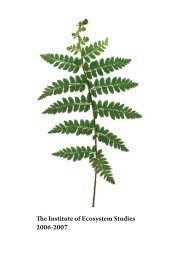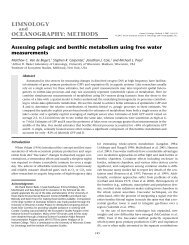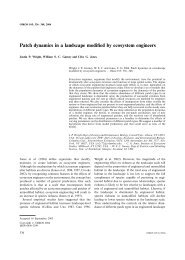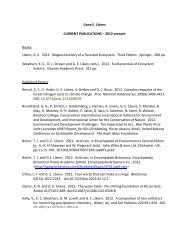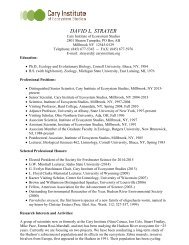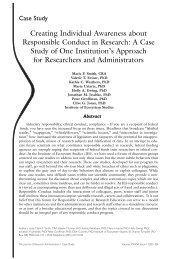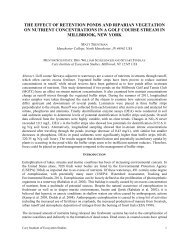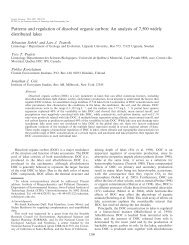Designed experiments: new approaches to studying urban ...
Designed experiments: new approaches to studying urban ...
Designed experiments: new approaches to studying urban ...
Create successful ePaper yourself
Turn your PDF publications into a flip-book with our unique Google optimized e-Paper software.
AJ Felson and STA Pickett<strong>Designed</strong> <strong>experiments</strong> in <strong>urban</strong> ecosystemsMatilsky 1992). Thus, in addition <strong>to</strong>showing the role art can play in generatingresearch with cultural meaning, hisefforts also represent an alternative route<strong>to</strong> funding <strong>urban</strong> ecological <strong>experiments</strong>.553East River marsh planterThe marsh planter project illustrates how<strong>experiments</strong> can combine education andaesthetics while acting as a functioningresearch <strong>to</strong>ol. In addition, it shows thatinstalling <strong>experiments</strong> in active <strong>urban</strong>zones creates opportunities for connectingthe public with ecological research. Theproposed project consists of a small-scale,experimental saltwater marsh planter <strong>to</strong>be constructed on Manhattan’s East River(Figure 4). The design, conceived by thefirm Ken Smith Landscape Architect, isintended <strong>to</strong> bring <strong>to</strong>gether aesthetics andfunction (Amidon 2005). With the EastRiver banks converted <strong>to</strong> vertical wallsand ocean-going boats creating severe wakes, the riparianedge is no longer hospitable <strong>to</strong> plant growth. Therefore,eight wooden planter boxes are <strong>to</strong> be placed on a pier,above mean high water, <strong>to</strong> avoid detrimental river conditions;saltwater grasses planted in the boxes will be grownin a sand and organic compost mix, with a bot<strong>to</strong>m layer ofwater-retaining polymers that substitute for the mud layer.The irrigation system will be flexible, including bothfreshwater sprinklers and an exposed saltwater system thatpumps water from the river in<strong>to</strong> the planters. Floodingwith the brackish East River water introduces nutrients,larvae, and minerals in<strong>to</strong> the constructed wetland.Scientists can develop small-scale controlled <strong>experiments</strong><strong>to</strong> study salinity gradients or <strong>to</strong> test res<strong>to</strong>ration techniquesand observe the creation of a mineral andnutrient plume below the planter, whichwill attract small bait fish and, in turn,lure larger preda<strong>to</strong>ry fish.Watershed 263Figure 3. Mel Chin’s Revival Field exemplifies an interdisciplinary approach <strong>to</strong><strong>urban</strong> research. Built between 1990 and 1993, it is located on Pig’s Eye Landfill inSt Paul, Minnesota.Long-term, large-scale, and planned mitigationsprovide an opportunity <strong>to</strong> buildand test multiple <strong>experiments</strong> within awatershed. Civic community engagementalso has a role <strong>to</strong> play in facilitating <strong>urban</strong><strong>experiments</strong>. The “greening” of a 367-has<strong>to</strong>rm drain watershed in Baltimore City,MD, is intended <strong>to</strong> reduce s<strong>to</strong>rmwaterflow and improve its quality (Figure 5).Plans involve increasing canopy coverand reducing the impervious cover onpublic lands. Numerous vacant lots, milesof piped streams, and under-used buildingsand infrastructure provide potential locations fordesigned <strong>experiments</strong>. Alterations in biodiversity, heavymetal pollution, microclimate, and a host of other fac<strong>to</strong>rscan be measured, along with the master variables of waterflow and quality, as greening in different sub-catchmentsproceeds. Through a partnership between ecologists anddesigners at Columbia University’s Graduate School ofArchitecture, Planning and Preservation, students areexploring experimental <strong>approaches</strong> for neighborhoodswithin the watershed (McGrath et al. in press).Partnerships between the city managers, not-for-profi<strong>to</strong>rganizations, and community groups are also proving <strong>to</strong>be important for the planning and maintenance of ecological<strong>experiments</strong>.Courtesy of M ChinFigure 4. The saltwater marsh planter by Ken Smith Landscape Architect,scheduled for construction in 2007, is an aesthetic research <strong>to</strong>ol adjacent <strong>to</strong> the 34thStreet Ferry Terminal on the East River in Manhattan. Drawing by author.© The Ecological Society of America www.frontiersinecology.org



